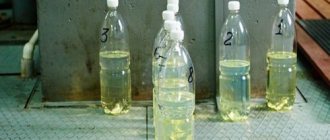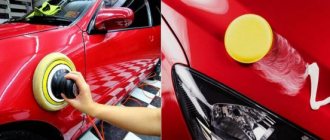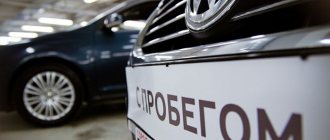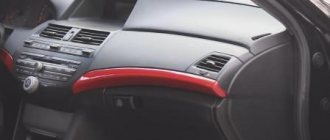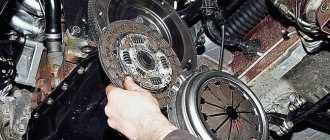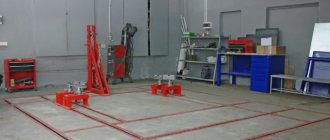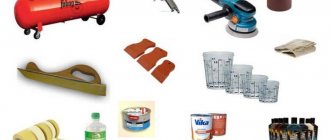The technology and quality of painting a car body are significantly influenced by the air temperature in the working area. Many car owners are interested in the question at what temperature a car can be painted so that the paintwork has high protective and decorative properties. In auto repair shops, for this process, paint booths are installed that regulate the air temperature. How can you create optimal conditions in the garage for painting a car?
Ideal temperature for painting
Vehicles are painted in auto repair shops in paint booths, which provide the necessary temperature conditions for work processes. Such cameras have temperature sensors. Drying painted cars does not always require high temperatures. Such conditions are created for certain types of automotive enamels that come complete with a hardener. In order to obtain a wear-resistant, strong, durable coating as a result of applying such paint on metal, the vehicle must be dried in a special box that provides a +80 ° C regime.
The ideal temperature for painting a car is considered to be +18...+22 °C, and the maximum permissible temperature is no less than +15 °C and no more than +25 °C. The puttying process can be carried out at an ambient temperature of +20 ° C, since the putty will not harden in colder air. Some inexperienced car owners who carry out paintwork in an unheated garage during the cold season consider adding more hardener to the putty as a way out, hoping for the composition to harden. This is a serious mistake, since excess hardener will not react, as a result of which the strength of such putty will be greatly reduced.
The modern building materials market offers a huge selection of automotive enamels for metal and plastic, which are applied and dried at a temperature of +20 °C. It is important that the required optimal temperature when painting a car is observed. Therefore, if you are doing repairs yourself in your garage, temperature sensors will not hurt you. Temperature conditions are important not only for the painting and drying process, but also for the stages of preparing the surface for painting. The type of solvent used and the interlayer holding time depend on the temperature in the room where the machine is painted. If you are going to paint your car at low temperatures or in a draft, be prepared for enamel smudges to appear. In addition, the drying time for each layer must be doubled.
Important! Do not heat consumables and the surface of the body with a hair dryer. The air temperature in the box, the surface of the car, and the car enamel should be the same.
Do not heat the part or consumable to be painted, this will lead to delamination of the coating, the appearance of air bubbles on the surface, and will reduce the wear resistance and durability of the paintwork. The same result will occur if the temperature in the garage or paint booth is too high.
Choosing car dealership services
Often, accidents on the roads occur in winter, which is associated with ice, snowfall or severe frosts. Damage sustained by a vehicle forces the driver to solve the problem promptly. This can only be done in a specialized car service center.
The quality of service painting is not affected by weather conditions and negative temperatures, since a special microclimate has been created in the salon. The organization providing the service selects the required premises and paint materials. Technologically complex painting with enamel, which hardens at fairly high temperatures, requires an individual approach.
Creating the necessary conditions for painting in the garage
At each stage of the painting process, it is important to maintain an air temperature of +20 ° C. This is possible using a special painting box (chamber). But even if you don’t have such a box or camera, you can equip your garage accordingly. To do this, you will need to install ventilation, an air heating system, and install thermoelements (sensors). There are several ways to heat a garage:
- you can install a regular gas, coal or wood heating boiler;
- connect air heating elements with a radiator into the heater and blow it with a fan, placing the structure outside the box;
- install an auto radiator with an engine from a heating boiler, providing air supply according to the recirculation principle for uniform heating;
- install a water heating system, replacing the batteries with auto radiators with an electric fan.
Under no circumstances use heating devices with an open spiral and an open flame to heat the air in the garage. This is a fire hazard! In addition, insulate the walls and floor of the room itself, and install a two-speed hood.
17.00–20.00: continuation of the working day
Until the evening, Andrei has two more clients and a lot of small but urgent matters.
“If there are no orders, I go into the office, check the corporate email, we have such a system that all calls from clients to the operator are forwarded here, and I have to call back. “More questions come directly from clients on Skype, and I also have to respond quickly.”
– A lot can be said about operating a car in winter. Of course, you need to wash it, although if in the fall the car is all covered in ordinary mud, and then winter salt gets on top of this layer of dirt, maybe it’s for the best. There are people who don’t wash their clothes even once all winter. But under no circumstances should you use scrapers to scrape snow off glass. This leads to microdamages, which may not be immediately visible, but will still appear later. It’s better to sit for an extra five minutes and warm up the car. And if the car does not warm up in 15–20 minutes, this is a reason to look for some kind of malfunction.
– Many people are generally afraid to paint their car in winter, they say, how will it dry? In fact, there is no difference at all: we paint in boxes and dry, so after painting you can drive safely. The painting itself does not take very much time; if, for example, only the bumper needs to be painted, I can accept the car in the morning and return it in the evening. If the whole car is being repainted and corrosion has already begun, then the preliminary preparation takes the longest: sanding it, getting the bugs out. And painting a new car if, for example, someone has touched a nail is easy.
How powder compositions are polymerized
Powder coating has great advantages over conventional liquid painting. They are provided due to the high protective properties of the created car body coating. Powder paint technology requires high temperatures for its polymerization, which is provided by special equipment equipped with temperature sensors. The powder coating process can be divided into two parts:
- applying powder to the surface to be treated;
- fixing the composition by polymerization.
During the spraying process, microparticles of paint receive a charge opposite to the charge of the car body. Opposite signs provide attraction, as a result of which the powder settles on the surface. The polymerization stage means that the applied layer must be fixed to the car body using a special hot oven. Under the influence of high (150-220 degrees) temperature, the dry layer will begin to melt, moistening the metal surface. To make the coating smooth and even, it is necessary to maintain a constant temperature in the oven, which is monitored by special sensors. The exact curing temperature and time depend on the paint, surface and equipment itself.
How long does it take for car spray paint to dry?
Aerosol varnish forms a coating that protects the surface from exposure to ultraviolet radiation and weather conditions. Some compositions give the product a glossy, 3D effect. The varnish is applied over all layers after they have dried.
There is also a technology that allows you to speed up the drying process of the varnish coating: spray the composition, heating the varnish aerosol to 70°C, onto a surface heated to +10°C.
The exception is the drying of the varnish film applied to metallic enamel. In this case, it is not recommended to reduce the drying time, so as not to cause a lack of adhesion between the metallic enamel and the varnish. The degree of drying is determined by lightly touching your finger: if the varnish is not smeared, then apply the next layer.
Necessary conditions for polymerization of low-temperature powder compositions
Not long ago, low-temperature powder paint appeared on the market of construction technologies and materials. This innovative product is designed for protective painting of structures and parts that cannot withstand high-temperature polymerization conditions. Low temperature coatings have:
- excellent technical characteristics;
- chemical resistance;
- excellent protective properties;
- can be smooth, glossy, semi-glossy, matte, transparent.
Low-temperature powder compositions can be used to paint not only automotive parts, elements, fittings, but also furniture, shelving and other products and structures.
Low-temperature powder compositions do not require high temperatures for polymerization; +70...+90 °C is enough for them. To maintain a constant temperature, thermoelements (sensors) are used. The use of this operating mode significantly saves energy, which is one of the most important factors when operating paint shops and enterprises. Therefore, low-temperature powder painting materials are quickly gaining leadership among all similar paints.
Previous Painting Painting a car with liquid rubber – a new look for your car Next
PaintingTypes of decorative painting of a car body
Additional tips and tricks
Powder paints provide the best and most durable body protection. But it is impossible to use such materials when processing a car in a garage, since during this procedure it is necessary to ensure prolonged heating of the car parts at a certain temperature. Therefore, for self-painting, you should use epoxy primer.
When processing the body, the temperature must not be allowed to rise above the established values. Because of this, the service life of the coating is shortened, and the paint begins to swell and peel over time.
Decoding the icons on clothesTest for cleanliness in your homeLaundry weight calculatorAsk a question to an expertShare link:Sources used:
- https://kraska.guru/kraski/rabota/mozhno-li-krasit-mashinu-zimoy.html
- https://mykrasim.ru/kraska/pokraska-auto/pokrasit-mashinu-zimoj
- https://hozzi.ru/kraski/primenenie/mozhno-li-krasit-mashinu-zimoj
When do you need to completely repaint your car?
There may be several such cases:
- The presence of a large number of defects (scratches, dents, rust spots) on the surface.
- The paint has faded badly in the sun.
- The need to replace individual parts (body, bumper, etc.).
- The owner's desire to change the color of the car.
Complete painting of the car can be done independently if you have such experience and knowledge, or in specialized auto repair shops.
It consists of main stages:
- Choice of paint (type, color).
- Washing, surface condition assessment.
- Disassembly, removal of interfering parts.
- If necessary, straightening, welding.
- Matting, degreasing, filling.
- Coating with primer, processing with sandpaper.
- Painting, car varnish coating.
- Drying.
This process is labor-intensive and time-consuming: two to three weeks or a month.
Drying features depending on equipment
The top layer hardens in 6 hours if no additional equipment is used. The paint hardens completely within a day. The exact drying time is indicated on the packaging.
The adhesion also depends on the drying method, for which special devices are used. They speed up the drying of the paintwork.
Convection method
The method allows the paint to dry quickly. The process is accelerated due to the large amount of heat flowing to the machine. The convection chamber functions like a fireplace with a fan, but the air is evenly distributed over the surface and does not go further.
The enamel dries quickly, but does not affect the adhesion of the paint to the surface of the car body.
Infrared method
In most cases, drying is carried out using the infrared method, which covers a space of 20-30 cm. The device is plugged into the network, but there are devices with a battery. The distance from the painted surface to the lamp should not be more than 50 cm. The device contains a cassette that changes the position of the device.
If the car is in a small garage, then take a compact device. In this case, the dried area of the painted surface will be small. Some models have a timer. It can be used to determine the drying time of paint and surfaces after painting.
Drying in a thermal chamber
In the thermoradiation chamber, drying occurs using infrared radiation. It comes from panels that are heated by gas, incandescent lamps and other elements. The temperature of the source affects the infrared wavelength and its length.
A flameless gas burner with ceramic nozzles that heat up and emit infrared radiation has a similar effect. This wave hits the coloring composition, and the metal is strongly heated.
Comments
For example, at 20ºС, 10-15 minutes of drying. I have never seen a minimum application temperature written on a can. Is it possible to use such paints at 5 - 10 degrees? There are probably experienced garage painters here.
This winter, during severe frosts, due to the hood, the temperature reached 8-10 degrees, everything worked out fine, but there was a very high risk of drips, it could have leaked in 5 minutes.
From +15 degrees, if less then even the putty will not polymerize.
I painted it at +1 hours 5, it turned out perfectly, I was shocked. I don’t want any more extreme painting, the car was a 2006 BMW3, silver, full paint
For half a year nothing happened to the car. Then they hit it in the back and I never saw the car again
the hairdryer is only for Gazelles and VAZs, I’ll try to explain why; When drying, the hair dryer heats and dries the top layer first, but the solvent remains in the bottom layer, which cannot come out due to the dried top layer. Correct me if I'm wrong.
Well, I use a hairdryer quite often on foreign cars, and it’s a very useful thing for straightening plastic. At low temperatures, below 20, it reduces the preparation time by half or even more, the main thing is not to overheat, I apply the putty and wait 5 minutes. I warm it up with a hairdryer, constantly stirring the hairdryer, if you keep it in one place, the putty will swell from overheating, wait until it cools down, and rub it in. The solvent in the putties is at least 2k in the primer, also if you don’t add it yourself, the boiling effect occurs in the paintwork in the 2k system from incorrect use of the hardener If the putty You need to heat it on the plastic very gently, just a little warm.
Each brand has technical documentation where everything is detailed in what temperature conditions this material is used, what drying time, etc.
potter27 › Blog › Complete repaint of the body. When repairs are for yourself, and not for sale.
Today I’ll tell you about how one of my readers asked me if I knew a good car service that could be trusted to completely paint a car. By a happy coincidence, I knew such a car service, moreover, I knew and personally know the painters in it. The only catch was that this place is located in Kolomna, that is, the owner had to drive the car a hundred kilometers away, leave it here for a month, and then come and pick it up. In general, there were no problems because of this, therefore, as of today, everything is ready. In this post, I want to look at some important aspects of painting a car, the economic feasibility of such work, and finally, whether it’s even worth spending a lot of money on painting an old car.
So, the car is a Volkswagen Polo 2009, hatch, 1.4, DSG, with a mileage of about 115t km. The car had previously had its entire left side and front bumper repainted. There were no serious defects at all: the bumper was worn in, scratches on the right rear door, chips, and also swelling of the paint after a previous, not very high-quality repair. There were also some minor scratches in the door frames. In order not to have to deal with a lot of local repairs, the owner of this Polo decided to “drench” the entire car.
There were two important points for the client: that it be of high quality and without any “jambs” and that they would not be deceived in issuing the final invoice for the work. I, in turn, decided to film the entire preparation process and the final result and show it to you. Therefore, you can see, it turned out to be two parts. The first includes an inspection of the car before starting work, measurements of the paintwork, and some aspects of the preparation process. About putty, primer, etc.
The second part contains the final result, as well as measurements of the paintwork after painting. The car's windshield and hood were also replaced with original ones and the body was covered with liquid glass.
This time I will not duplicate the video with pictures and text, for those who are interested - look, no, no. I want to supplement the video with thoughts about the economic feasibility of this event and talk about whether it was worth repainting your cars at all due to cosmetic defects.
Full body painting cost the owner 80 rubles. I will say right away that it was absolutely not advisable to do this, if we talk about the further sale of the car. It didn’t become 80tr more expensive. This is not a car to which the term restoration can be applied. It's another matter if a person likes his car and wants it to look good. This is the same thing when people make expensive and high-quality repairs in their Khrushchev apartments, investing a third of the total cost of the apartment itself. We make a lot of such economically unfeasible investments in life, simply because we do it for ourselves. For example, buying a new car is, in principle, a bad investment, but people buy them with pleasure, often even on credit, just for the impressions and sensations of a new car. All this means that a reasonable adult who earns money on his own has the right to spend it as he sees fit.
The whole question is how well the work will be done, for example, the guys in my garage cooperative paint cars cheaply for sale.
Source
Upon completion of work...
There is another important aspect in the work of a painter, which is usually not given serious importance. This is washing the gun after working with metallic. If you do this operation carelessly, then particles of “silver” may remain in the gun, which then either clog the nozzle and spoil the shape of the torch, or fly to the surface during the next painting.
Therefore, upon completion of work, you need to take care of the cleanliness of the tool. The spray gun is thoroughly washed with solvent and blown with compressed air. Don't waste your time and energy on this.
Rejoicing with all your heart at the shine of a wing or hood painted after repair, and even metallic, and even silver, and even without “apples”, and even... (sorry, I got carried away) you inevitably feel the joy of owning a car. Yes Yes! It is so beautiful, shiny, smooth, fresh, inimitable, perfect, corrosion-resistant, on four wheels, five-speed gearbox... Sorry, we got carried away again...
What is a paint booth
This is a room in which ideal conditions are created for painting the car body. Creating such a room is not easy, but with the right approach and full technical equipment it is quite possible.
Not all service stations follow the painting rules and very often use a repair box for painting work. As a result of such violations, the coating on the car quickly becomes unusable, and the owner is forced to seek help again.
The choice of room for a painting booth must be done wisely. It shouldn't be too small. Here you will need to place a fairly large amount of equipment and organize a high-quality ventilation system.
spray booth
Requirements for the premises under the painting booth:
Here's how a paint booth works. In such a scheme, everything is thought out to the smallest detail; all that remains is to show creativity and come up with a coating for the walls and ceiling that meets the high fire safety requirements. The most common is sheet metal, painted white.
The white coating helps the master to clearly see the shades of colors and does not in any way affect the perception of the color palette.
Before…
Considering that each person has a certain degree of figurative representation of a particular process being described, and also in order to give our “technical” narrative a little artistic style, we will clarify what, how and with what we plan to paint.
Let's say we were damaged in an accident, and then a beautiful, modern, new, expensive, elegant (I think there are enough adjectives to scare you a little) car, painted a light silver metallic, was restored and prepared for painting.
Without delving into the initial nuances of damage, repair or replacement of this or that part, we will dwell on the fact that the restored body elements are primed over the entire plane, thoroughly sanded (for metallic this is done with abrasive material P400-P500 “dry” or P800-P1000 “ wet") and are designed for complete repainting. This is important, since in this case there is a serious question about the accuracy of selecting the shade of enamel, or the need to make a smooth transition to adjacent elements.
By the way, for our example it was not without reason that silver metallic was chosen. Light and silver colors contain a lot of aluminum grain and reflect light fluxes extremely unpredictably, therefore, compared to dark “metallics”, they are especially difficult to repaint.
Why turn on the air conditioner in winter?
This advice definitely seems unexpected. Where is winter and where is air conditioning. But this is exactly what experts advise: you need to clean your air conditioner before the start of winter. And that's why.
If this is not done, bacteria and fungi will begin to multiply in the dust, pollen, and particles of debris that enter the radiators and filters of the air purification system along with the air from the street. As a result, the very first turn on of the air conditioner in spring, instead of pleasant freshness, will give you a completely different feeling.
The second stage follows from the first stage. In winter, the air conditioner must be turned on. At least a couple times a week. The components of the air conditioning system require lubrication, and its role is played by the refrigerant circulating through the air conditioner pipes. If the system is idle and inactive, a thin film of oil flows down, leaving parts unprotected.
Our expert warns that the air conditioner itself will not turn on in winter; this must be done forcibly. Or use the windshield blowing mode. In this mode, the air conditioner turns on to dry the incoming air and deal with fogging of the windows.

